Indoor photovoltaics might seem counterproductive. But they offer a better power source for the proliferating number of sensors that will drive the growing Internet of Things.
MICHAEL EISENSTEIN, CONTRIBUTING EDITOR
Readers of a certain age may recall getting through math and science courses with the assistance of a trusty solar-powered calculator
that could harvest just enough ambient light from the classroom
to power its rudimentary electronics and LCD screen. For many years, such devices were something of an anomaly in an otherwise wall plug- and battery-powered world, where most gadgets were too sophisticated to get by with just a few microamps of light-generated current.
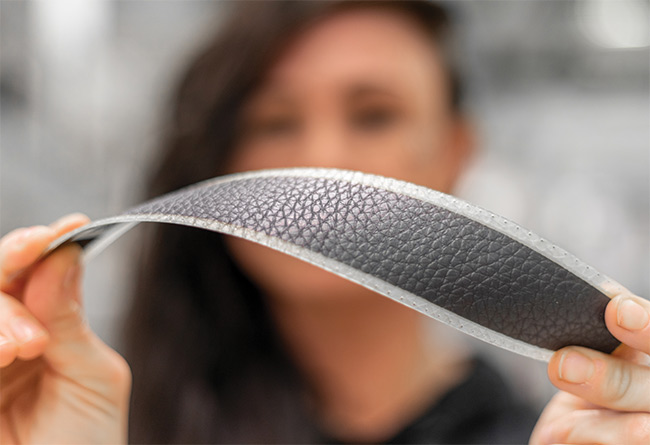
Indoor-photovoltaic developers are leveraging new materials, manufacturing methods, and robust packaging to employ ambient interior lighting to power the emerging Internet of Things. Courtesy of Exeger.
But indoor photovoltaic (PV) cells are poised to expand in the next few years, thanks to growing demand from the Internet of Things (IoT): a constellation of tiny, networked sensors and other devices that transmit and receive information via Wi-Fi, Bluetooth, or radio frequencies. “All of a sudden you have a lot of devices that need very little power — but they still need power,” said Jonas Bergqvist, CTO at Epishine in Linköping, Sweden.
Indeed, recent analyses of the IoT market by Gartner suggested that the market could fuel a total number of sensor devices reaching 43 billion this year — with the potential to leap to a trillion devices by 2035. Battery power is neither a practical nor a sustainable solution to this explosive growth.
“If you were to calculate how much lithium you would need to power trillions of sensors in terms of batteries, you would find out that current annual global lithium production is not sufficient to meet that demand,” said Vincenzo Pecunia, who studies sustainable energy engineering solutions at Simon Fraser University in Surrey, British Columbia, Canada.
Even if sufficient batteries were available, this solution would generate a vast amount of electronic waste and require considerable labor and effort to keep billions of IoT sensors up and running.
Although still a relatively nascent technology, indoor PVs have come a long way since the days of solar calculators. A few suppliers have already begun commercial deployment, and several startups are now moving their technologies into production. Exeger, based in Stockholm, already has seven indoor PV-powered products on the market, ranging from networked electronic shelf tags for retail applications to rechargeable consumer headphones. “Now we’re at 200-plus employees, and we’ve got two factories,” Exeger founder and CEO Giovanni Fili said.
Despite this momentum, or perhaps
because of it, indoor PV technology is still defining its path forward. With
multiple different indoor PV solutions available, for example, and no robust standards to compare or quantify the
performance of these devices, potential users might find this promising field challenging to navigate.
Surpassing silicon
The same core principle applies to both indoor and outdoor PVs — convert photons into electrons. But the operating conditions are very different. Crystalline silicon remains the undisputed king of the outdoor solar market. Commercial cells have well-established durability and photoconversion efficiency around 20%.
But indoor light differs dramatically from sunlight. It emits almost exclusively in the visible spectrum without the ultraviolet and infrared wavelengths that
appear in solar radiation.
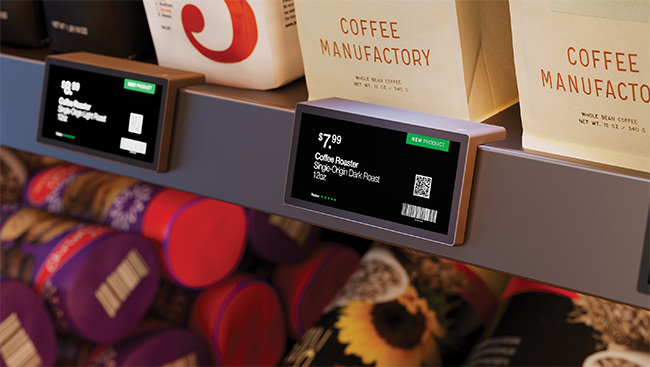
Light-powered electronic shelf tags are among the first wave of applications for indoor photovoltaics, where the ambient light in a retail establishment can power vast numbers of product labels. Courtesy of Ambient Photonics.
Crystalline silicon has a bandgap in the range of 1.1 eV, which is particularly well suited for achieving excitation at the near-infrared end of the spectrum, but it is a poor match for converting LED or fluorescent light, where the ideal bandgap is closer to 1.9 eV. Therefore, using crystalline silicon for indoor PV modules would result in a great deal of wasted energy indoors.
“Indoor light has fewer photons than direct sunlight by several orders of magnitude, so high power density is a must,” said Bates Marshall, CEO and co-founder of Ambient Photonics in Scotts Valley, Calif.
Solar calculators employ amorphous silicon, which has a bandgap of 1.6 eV that is more suitable for deriving energy from indoor light sources. But indoor PVs using this material can still only achieve modest conversion efficiencies from 4% to 9%. It’s a challenge to get consistently high performance from amorphous silicon, Bergqvist said. Accordingly, most of the current generation of indoor PV suppliers and research groups are turning to alternatives to this legacy material, including perovskites, organic photovoltaics (OPVs), and dye-sensitized solar cells (DSSCs).
Perovskites, a category of materials with a distinctive crystalline structure that can be tuned to achieve a powerful response to various optical wavelengths, have already generated considerable excitement in the outdoor solar market. In the past 15 years, the peak conversion
efficiency achieved with perovskite solar cells has leapt from 4% to 25%, and some groups are now looking to leverage this performance for indoor applications. For example, Saule Technologies, based in Warsaw, Poland, recently launched a line of digital retail shelf tags powered entirely by perovskite-based PV cells.
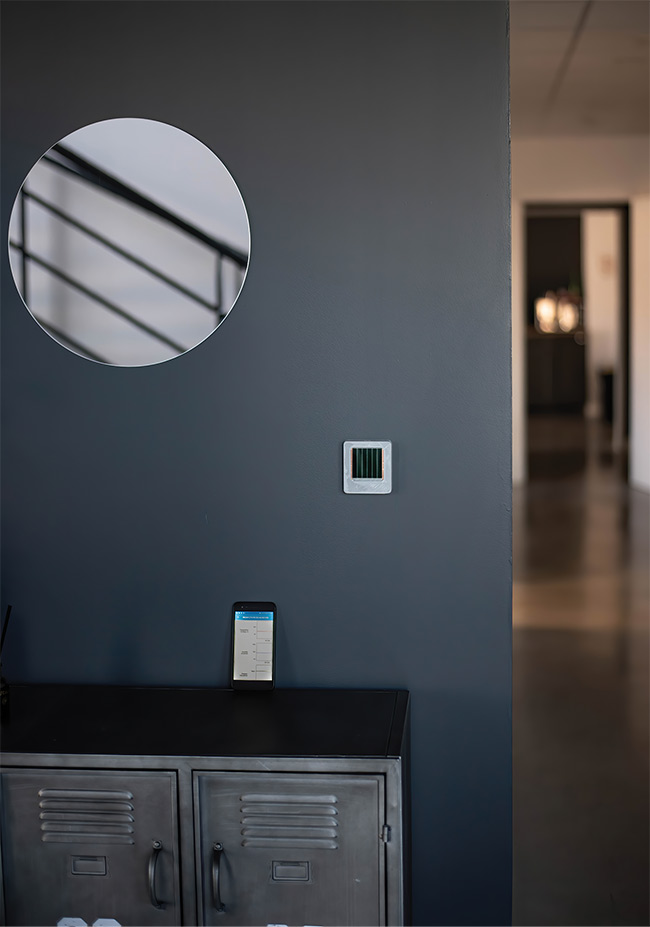
Lighting conditions can vary considerably indoors, and standardized measurement and planning methods may be required to find the ideal place to situate fixed-position photovoltaic-powered indoor devices such as temperature or humidity sensors. Courtesy of Dracula Technologies.
There are some environmental concerns around conventional perovskites, which typically are fabricated from toxic lead halide building blocks. Pecunia’s research group is exploring the development of lead-free perovskites, which are based on elements such as tin, antimony, or bismuth. Although currently less effi-
cient than lead-based perovskites, these materials are evolving rapidly. “The latest bismuth-based materials are approaching 10% efficiency under indoor illumination, which means that they are already ahead of commercial amorphous silicon,” Pecunia said.
Most commercial activity in the indoor PV market today revolves around OPVs and DSSCs, a pair of light-harvesting technologies that can currently achieve peak conversion efficiencies in the 30% range. OPVs employ a combination of “donor” and “acceptor” organic polymers. Incoming photons energize excitons in the donor that generate currents at the donor-acceptor interface. Epishine, Dracula Technologies, ASCA, and Ricoh are among the companies pursuing OPV-based products.
DSSCs emulate the photosynthetic process that occurs in plants, wherein light excites a photoresponsive dye — except in this setting, it leads to the release of electrons that subsequently travel to an adjacent semiconductor layer where they are relayed to an electrode. The dyes must be chosen carefully to ensure that sufficient excitation takes place. “Our team developed more than 40 novel organic sensitizer molecules for creating proprietary metal-free, synthetic, organic dyes,” said Marshall, whose company is developing DSSC-based indoor PV cells. Exeger and Sharp are also exploring this technology for indoor systems.
Measuring performance
Picking the right indoor PV technology is not simply a matter of ranking options based on their conversion efficiency. Sadok Ben Dkhil, CTO at Dracula Technologies, notes that although there are well-defined standards for measuring and validating the efficiency and long-term performance of outdoor solar cells, “for indoor photovoltaics, unfortunately, there are no rules.” This is partly because indoor lighting can be much more heterogeneous than the sunlit world. Indoor environments rely on a diversity of lighting sources of various intensities, distributions, and illumination profiles, and an indoor PV device might be situated in any number of positions relative to these illumination sources. Efforts to develop standards are in the works but, in the meantime, conversion efficiency alone offers a limited metric by which to measure a light-harvesting unit’s real-world performance.
Most manufacturers describe the performance of their indoor PV devices using tables listing the power density that can be achieved under various levels of ambient light, as measured in lux units. This metric captures the amount of current produced per square-centimeter of an indoor PV’s active surface. This would indicate that even a relatively inefficient cell can be potentially scaled to deliver sufficient power for a given task — which makes the final form factor of the device an important consideration.
“Form factors for indoor PV cells commonly measure a few centimeters by a few centimeters maximum,” Pecunia said. Wireless communication is typically the most power-intensive component in simple IoT devices such as shelf tags or temperature and humidity sensors. But low-power communication protocols are available that require 100 µW of power or less to operate. This is an accessible threshold for indoor PV devices. For example, Marshall said that Ambient’s DSSCs can produce 15 µW per square centimeter from ambient light under 200 lux, which is typical for residential spaces and well below the brightness of a typical office.
Device durability is also an important consideration for designers. Indoor PV devices have a considerable edge over outdoor solar cells in that they are subject to milder conditions in terms of heat and humidity. Perovskites, OPVs, and DSSCs all have a history of struggling to achieve the kind of stability offered by crystalline silicon, although newer generations of these materials and improved manufacturing processes are delivering far greater longevity.
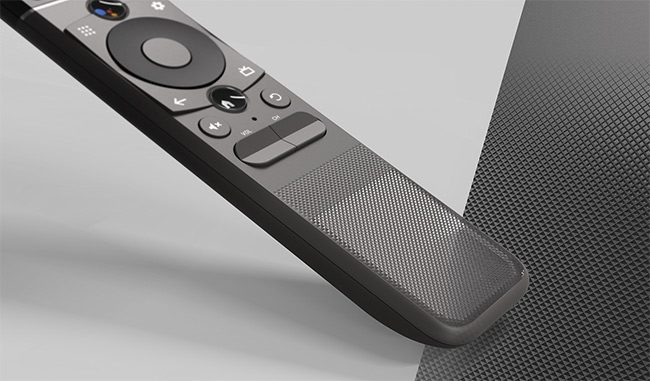
Remote controls consume tiny amounts of battery power, which makes them an ideal candidate application for indoor photovoltaics. Courtesy of UEI.
Exeger, for example, developed an indoor PV architecture in which a dual-sided DSSC is surrounded by a liquid electrolyte that is laminated between two plastic sheets. Fili describes the resulting configuration as a “peristaltic pillow” that readily withstands abuse. “We can drop steel balls on the cell or hit them with
a sledgehammer, and nothing happens,”
he said.
There is also a fair bit of educated guesswork in determining the maximum lifespan a given indoor PV device can achieve. Bergqvist said that Epishine products have demonstrated stable performance for up to two and half years. The company further performs accelerated testing for dampness, heat, and light-soaking to then try to extrapolate reliability after 10 years, Bergqvist said. “Nevertheless, more time and testing will be needed before the true lifespans of these systems are formally established,” he added.
There is also the matter of cost. Indoor PV devices that reach the market seldom match the lofty performance described in peer-reviewed articles or press releases describing R&D breakthroughs simply because the manufacturing processes
involved cannot deliver that level of quality at scale at a reasonable cost.
Fortunately, suppliers are finding ways to achieve robust and consistent performance without making their technology prohibitively pricey. Careful choice of materials is one factor.
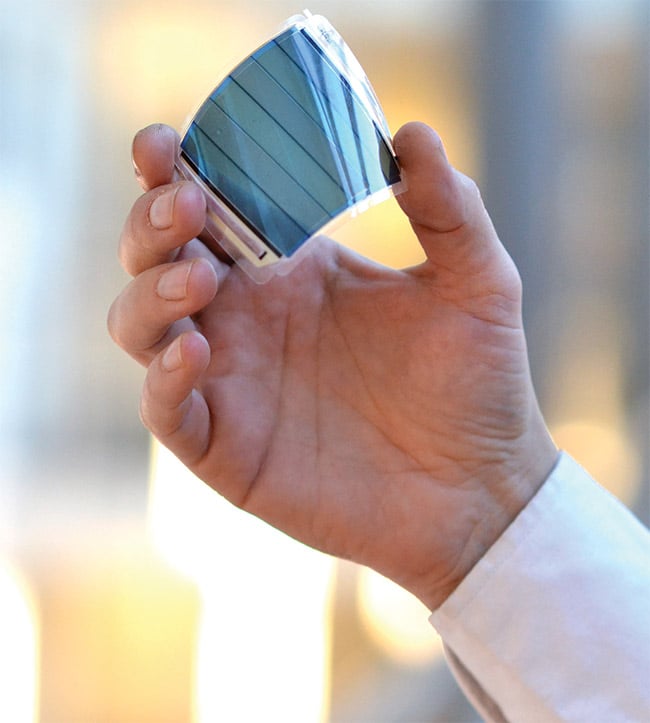
By producing photovoltaics based on durable, flexible materials, manufacturers can greatly extend the range of use cases for light-powered indoor electronics. Courtesy of Epishine.
For example, Ambient has developed dye formulations that eliminate the need for ruthenium, an expensive precious metal that is a standard component in many DSSCs. “This allows for thin, durable, and reliable cells at a fraction of the cost of conventional [indoor] PV technology,” Marshall said.
The choice of manufacturing method matters as well, and many companies are employing printing-based additive manufacturing approaches that reduce waste and confer greater latitudes to indoor PV design. Dracula is using a unique inkjet-based approach, for example, that enables rapid prototyping and development. “If you give me a design on Monday, on Friday I can give you prototypes of 10, 100, or 200 devices,” Dkhil said.
Other companies use an alternative known as roll-to-roll processing that may be less flexible than inkjet printing but is a more cost-effective choice for large-scale manufacturing.
Hitting the shelves
Only a few companies in this sector are already operating at production scale and forging commercial partnerships. Exeger currently produces light-rechargeable headphones as part of a partnership with Adidas, and in January, they announced a strategic partnership with SES-imagotag, a manufacturer of electronic retail signage, to integrate Exeger’s DSSC technology into their products.
Meanwhile, in November, Ambient broke ground on a factory that Marshall said will have a production capacity of tens of millions of units per year, and both Dracula and Epishine are also in the process of constructing factories to scale toward volume production.
Most of the early forays in this space have converged around the same broad categories of products: IoT sensors, digital signage, and low-power-consumption consumer electronics such as TV remotes or computer mice. These first-generation products have offered valuable learning opportunities in how best to deploy indoor PVs in real-world settings. For example, before installing a light-powered device in a residence or office, customers need to be sure the system will achieve stable, steady performance. Many indoor PV
suppliers thus offer lux meters and consult extensively with potential users to ensure that they are making the most efficient use of indoor PV harvesters.
For portable devices such as remotes, indoor PV manufacturers further need to find solutions for challenges such as seamlessly incorporating their panels into existing electronic products, and identifying effective methods for storing excess energy for use when light is lower or entirely absent. “We have a team of five people working full-time on supporting our potential customers on this,” Bergqvist said.
After years of initial skepticism, interest from the electronics industry is now surging. Many indoor PV suppliers drew considerable crowds at this year’s Consumer Electronics Show in Las Vegas.
“We had one suite booked and we had to arrange two more,” Fili said. He believes that the technology can ultimately be leveraged to power and recharge a much broader range of consumer products in the future. But even if its immediate impact is limited to low-cost sensors and other electronics, the benefits could still be considerable in terms of building out expansive IoT-based information-gathering networks.
“We can collect, process, and transmit a lot of data,” Fili said. “And when this goes into AI-powered systems, it’s going to have tremendous impact on how we perceive, predict, and optimize things.”